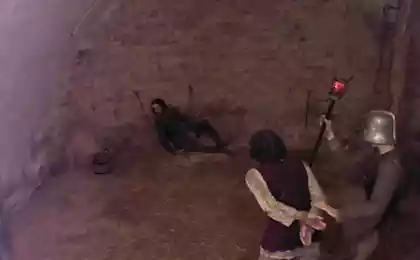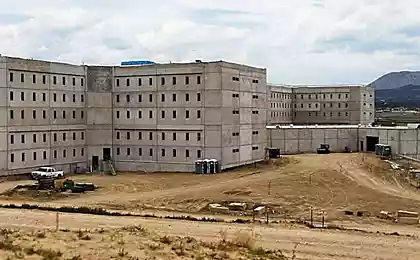2572
Escapes from prison
September 17 from the city jail Piedras Negras Mexican city escaped 132 prisoners. Mexican authorities say that the escape was made through the main gate, and not through the tunnel, as previously reported. Apparently, the prison guards were in cahoots with the prisoners, and the escape was made with the support of one of the drug cartels - Los Zetas. There is an ongoing search of fugitives. For any information on fugitives a reward of 200,000 pesos ($ 15,000 USD).
Escape from Mexican prison - not only of its kind. History remembers many successful and arrogant shoots. Suggest Top 10 most daring, ambitious and daring escapes from prisons and camps.

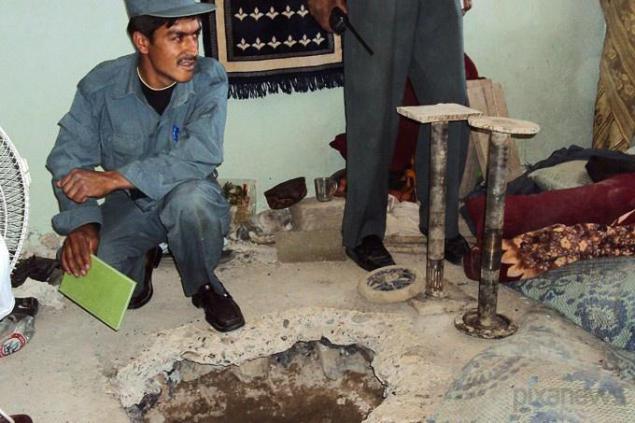
Taliban tunnel. Five hundred Taliban fled through a tunnel from the Afghan prison "Sarpuza" in 2011.
From 24 to 25 April 2011 from the Afghan prison "Sarpuza" that is in the Afghan province of Kandahar, about 500 prisoners escaped. They took advantage of an underground passage length of 320 meters. The tunnel led into a small house, which was bought out by the Taliban. At the appointed time arrived to the house transport, which brought all the fugitives. Escape has become not only as a blow to the back of the Allied Forces and the biggest failure of local authorities. Of five hundred escaped only one prisoner serving a sentence for a criminal offense, all the rest - for terrorist and subversive activities. Of the 500 prisoners about a hundred were directly related to a Taliban commanders. As a result, after the measures taken, found only 26 prisoners, two of whom were killed during the arrest.
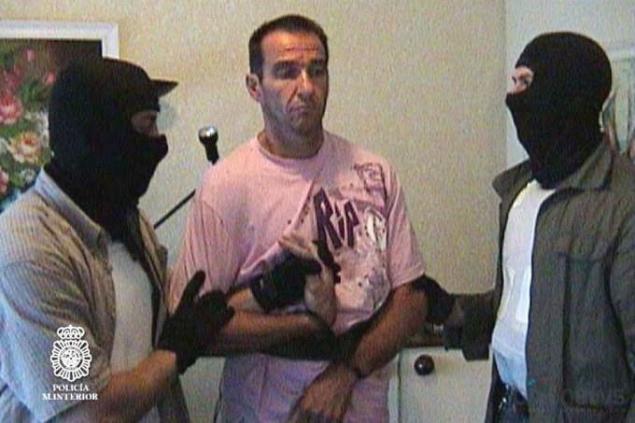
Three-time escape by helicopter. Marseille criminal Pascal Payet was chosen from three French prisons.
In 1997, Pascal Payet adventurer took part in the attack on the collector car of the Bank of France. During the robbery, Pascal Payet has released a full magazine AK-47 in the gut to the collector, another collector was injured (for which, incidentally, Pascal called "Kalashnikov"). In January 1999, Pascal was arrested in Paris. While he was awaiting trial, his residence was the prison of the Bouches-du-Rhone. Waiting dragged on for two long years. And so, in October 2001 over the prison courtyard helicopter hovered controlled accomplice Payet. Just a few minutes it took two prisoners to get inside the aircraft and gain freedom.
In 2003, he and his accomplices attempted to regain the freedom of his friends, who participated with him in the attack on collectors. Payet and his accomplice, wearing masks and armed with machine guns, stolen helicopter. They ordered the instructor to fly up to the prison yard and stay in the air. Payet partner went down to the prison by sawing through bars on the chambers of three prisoners, and together they returned to the helicopter by a rope ladder.
In January 2005, the court sentenced to 30 years in Paye 'imprisonment for the murder of the collector, to the same term was added to 13 years for taking part in two shoots. Payet got the official status of the perpetrator, of which require special care. Within two years, he was transported from one prison to another every three months to prevent another escape. But it did not help. During the celebration of Bastille Day July 14, 2007, four accomplices kidnapped Payet helicopter near the town of Grasse prison, two masked men came down the rope from a helicopter, and then use the gas-welding machine has opened the door ready to run Pascal Payet. The Fugitive caught after three months in the village Mataro north of Barcelona. Today, its location was not disclosed for security reasons. But who knows, who knows ...
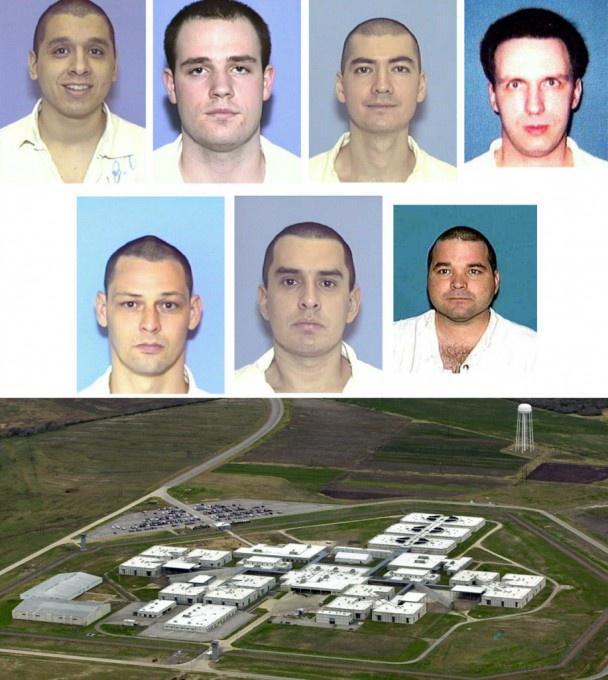
The Texas Seven: escaped from prison with the highest level of protection using highly-researched plan.
December 13, 2000, seven prisoners John Connally Unit - the most guarded prison in Texas Karnes County - escaped using a complex scheme. Using several well-planned ploys, the seven criminals disarmed and locked the nine prison guards, four employees of correctional institutions and three uninvolved inmates in the escape plan. Escape occurred during the quietest period of the day when the surveillance area for tehobstuzhivaniya minimized - during lunch and during accounting. Most of these tricks involved one of the criminals, someone calls out, while the other was hitting about anything unsuspecting person back of my head. Once the victim was defused, the criminals took away a piece of clothing, tied her and locked in a transformer. The attackers stole clothing, credit cards, and identification of the victims. The group also gave herself on the phone and prison officers to make false calls to remove the suspicions of the authorities. After that three members of the group in stolen civilian clothes forced their way to the back gate of the prison. They impersonate electricians who had to install video monitors. A guard at the lodge was neutralized, after which the trio raided the guard tower and stole a lot of weapons. Meanwhile, four other criminals called the guards this very tower towers to distract them. Then they stole a pickup staff, which drove up to the back gate, and took his comrades left prison.
Typically, after the group dispersed prisoners escape, but in this case the opposite has happened: the criminals have formed an armed gang. Seven has been a leader in the ranking of the most dangerous criminals, who is wanted in the United States. Texas police announced a reward of $ 200 thousand dollars to anyone who will assist in the capture of armed bandits. A year later, the gang hunted down and caught, which contributed to the TV show America's Most Wanted. After catching criminals, they had found 60 firearms and plenty of ammunition.
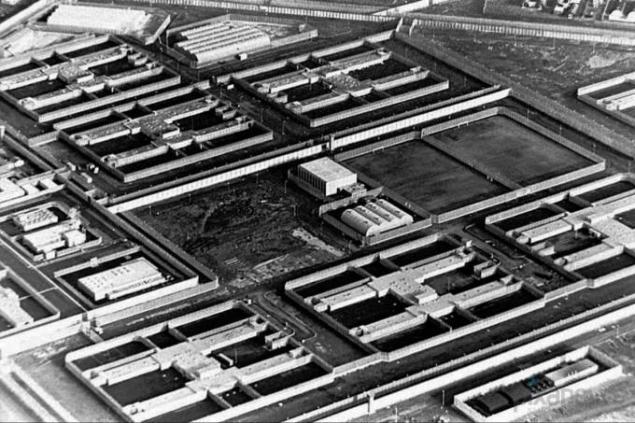
Jailbreak "Maze". Thirty militants fled the Irish Republican Army in 1983.
The loudest escape in British history took place September 25, 1983 in Antrim, Northern Ireland. Thirty-eight members of the Irish Republican Army, accused of numerous murders and attacks, escaped from H-Block №7 (H7).
As a result, injured 21 people, including one police officer died of a heart attack, and two inmates were wounded and returned to prison. Maximum security prison "Maze» (Maze) was considered one of the best in Europe.
In addition to 4, 5-meter fences, each H-Block was separated concrete 5, 5-meter-high wall, the top of which was barbed wire, and the gates of the whole complex is electronically controlled and were made of solid steel.
At 2:30 AM the prisoners captured H-block and kept guard as hostages. Some prisoners took the clothes and the keys to the car guards. At 3:25 to prison truck arrived with food. Prisoners forced the driver to go with them. At 3:50 of the H-block left the truck in which there were 38 people.
A few days later were captured 19 prisoners. Other prisoners helped hide the representatives of the Irish Republican Army. Some of them moved to the US, but were later found and extradited to Britain.
Because of the policy in Northern Ireland, one of the remaining fugitives more and not actively sought, some of them have received amnesty.
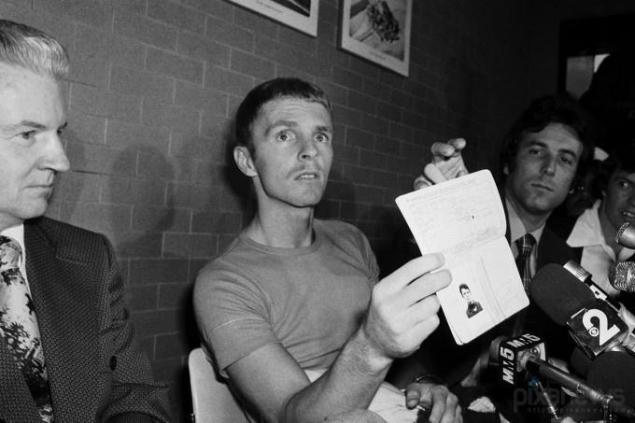
Billy Hayes: escaped from a Turkish prison and became a writer.
Sentenced to 30 years in a Turkish prison for smuggling two kilograms of hashish in 1970, 22-year-old American Billy Hayes was originally sentenced to four years and two months in a Turkish prison; a couple of weeks prior to the deadline, he learned that the authorities decided to sentence him to 30 years in prison, so he decided to escape. After 6 months of planning, he got into a fight with a security guard, stole his uniform, and, taking with him $ 2,000, which his father had smuggled into prison in an album with photos, Hayes stole a rowboat, sailed from the Turkish island of Imrali, where a prison, and went towards Greece.
Barefoot, hungry and without a passport, he swam to an unknown shore. When Hayes finally came upon an armed soldier, Billy thought he had lost his chance at freedom, but the soldiers started shouting at him in Greek, which meant that the border he still moved. Ultimately, Hayes returned safely to the United States, and then wrote for publications Midnight Express (Midnight Express) autobiographical book about his life in prison and escape from there.
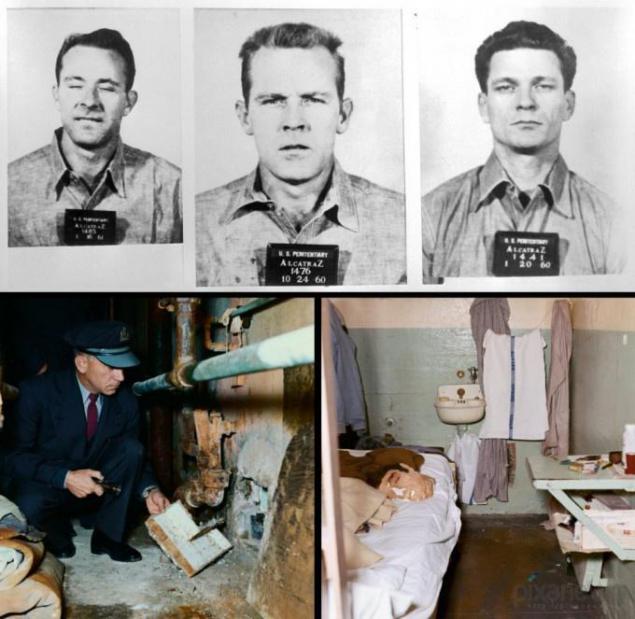
Frank Morris, John Anglin and Clarence - the only prisoners who escaped from Alcatraz.
Over the 29 years of the prison Alcatraz from it many times tried to escape. According to prison records, was just 14 escape attempts, which involved 36 prisoners (two of them - twice), 23 were caught, six - shot and killed during the escape, three were lost at sea and no one more of them have not heard - their bodies were never found.
But June 11, 1962 Frank Morris with his brothers John and Clarence Anglin successfully completed one of the most intricate escape plan ever developed. Morris and Anglin climbed up the ventilation shaft and through one of the chimneys climbed onto the roof. The trio then went down the roof and floated away from the island on rubber rafts. The next morning police searched for the escapees to Alcatraz, but to no avail.
The warden explained that the prisoners did not immediately missed due to the fact that they put fake head made from a mixture of soap, toilet paper and real hair on their bunks, and fooled than prison officers conducting inspections at night. Anglin brothers Morris and subsequently disappeared without a trace and still wanted by the FBI, although they are believed to have drowned in the Bay of San Francisco, trying to swim away from the island.
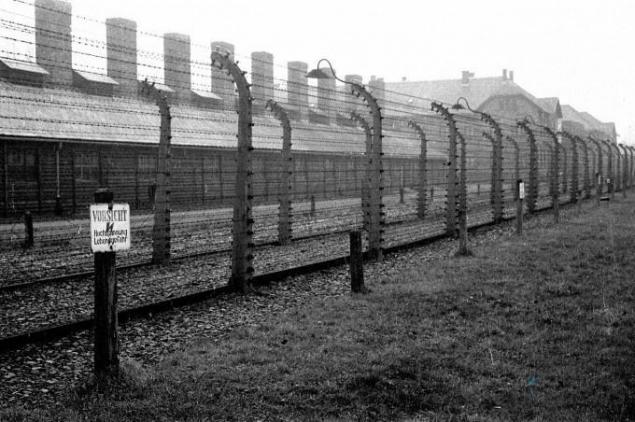
Alfred Wetzler and Rudolf Vrba: escaped from Auschwitz, and later made subsequently saved many lives a report on the Nazi camp
Wetzler was a Slovak Jew, and one of the few Jews who escaped from Auschwitz concentration camp during the Holocaust. Wetzler escaped with the same as he was a Jew named Rudolf Vrba. With underground camps 2 pm on Friday, April 7, 1944 - the eve of Passover - the two men hid inside the wooden piles, which was intended for the construction of the section "Mexico" for newcomers. She was surrounded by barbed wire inner perimeter of Birkenau, but in the outer perimeter guards remain vigilant throughout the day. Other prisoners spread around the board sunken area to hide the men, and then sprinkled the area with acute Russian tobacco soaked in gasoline to fool the dogs. Vrba and Wetzler hid for 4 nights - to be caught again.
April, wearing Dutch suits, coats, and shoes that they took from the camp, they moved south, running parallel to the river Sola and reached the Polish border with Slovakia through 133 kilometers. They found their way through the page torn from a children's atlas that Vrba had found in the warehouse.
Wetzler and Vrba later became known thanks to the report, in which they describe the internal structure of the camp Auschwitz - the plan area of the camp, the construction of the gas chambers, crematoria, and most convincingly, the label on the cans Zyklon. These 32 pages were the first detailed report on Auschwitz, which reached the West and that the Allies regarded as credible. They say that this report has saved 120,000 lives.
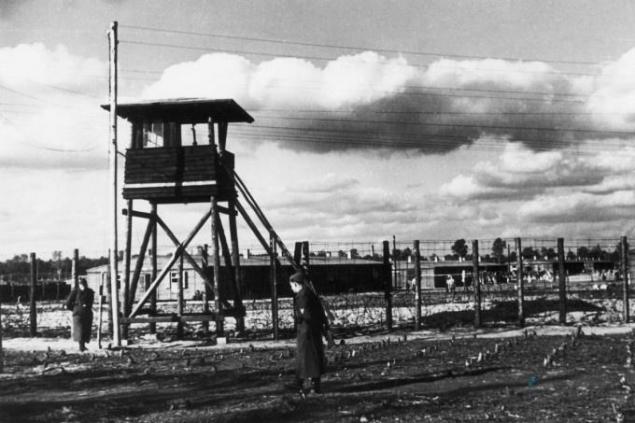
POW Escape from prison Sagan. March 24, 1944, Sagan, Poland
This well-known, well, we can say, masterfully planned escape from Nazi Stalag backlash 3 Sagan in Silesia, Poland, and the special features easy insolence. It was conceived in 1943 by Roger bushels (Roger Bushell). 76 American and British prisoners have made tremendous efforts to dig three separate tunnels that gave even the code name "Tom", "Dick and" Harry "- in case if one of them will be detected. Tunnels over 600 prisoners worked for 11 months.
Fugitives managed to get civilian clothes and fake cardboard testimonies Polish, Yugoslav and Bulgarian workers. In addition, they have learned a few necessary precaution phrases in German.
"The Great Escape", as it was called prisoners of war, was made on the night of 24 to 25 March 1944 through the tunnel "Harry". Unfortunately, only three of them (the British pilots of the Air Force from Scandinavia) of the 76 escapees managed to get home. The remaining prisoners were captured, and 50 of them were shot on the personal orders of Hitler.
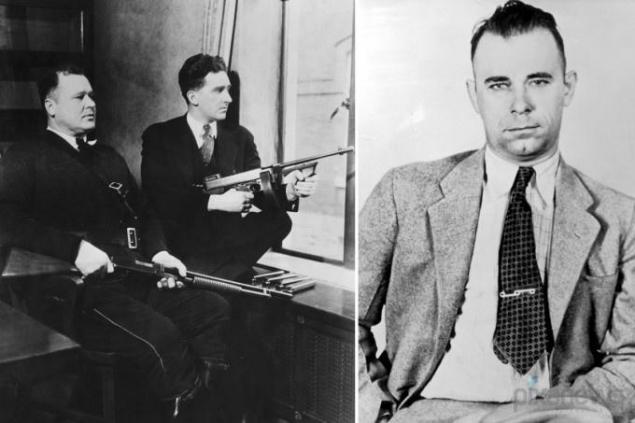
John Dillinger: escaped from jail using a fake gun made of wood and painted in black shoe polish.
The legendary Johnny D, which by the way he played his namesake Johnny Depp in the Hollywood movie, the American bank robber 1930s, robbed at least two dozen banks and twice escaped from prison. Dillinger spent some time in prison in Michigan, Indiana, until in 1933 was not paroled. 4 months later, he again went to prison - this time in Lima, Ohio, where he was rescued his armed gang, killing the jailer, Sheriff Jesse Serber. Most of the gang was caught in the same year at Arizona Tucson, during a shootout at the historic Hotel Congress. Dillinger was placed in jail in Lake County, Indiana Crown Point. He was charged with attempted murder of a police officer William O'Malley during a bank robbery in East Chicago, Indiana, implemented almost immediately after Dillinger escape from prison.
March 3, 1934 John D escaped from Crown Point (prison, from which at the time was considered impossible to escape), which was guarded by a huge number of police and military of the National Guard. The newspapers immediately came the news that Dillinger escaped from prison with the help of a fake gun made of wood and painted in black shoe polish. With this gun he forced the guard to open the door of his cell, and then took two hostages, gathered all the guards in his cell and locked them, and he quietly got out of prison.
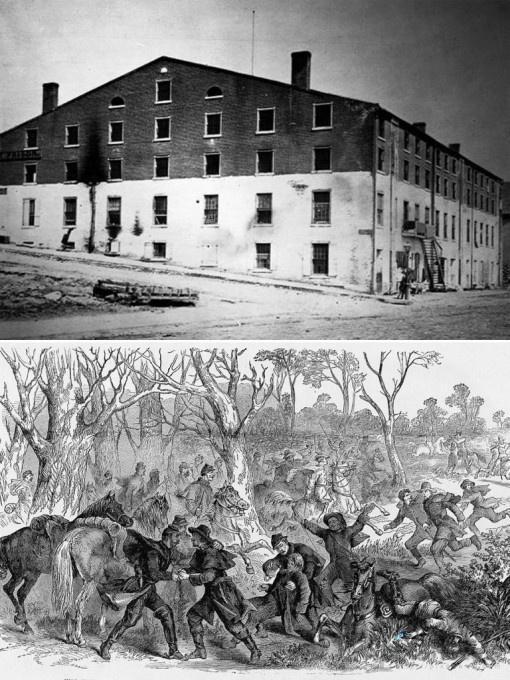
Prisoners "Rat Hell": the most famous (and successful) escape during the American Civil War.
Jailbreak Libby was one of the most famous (and successful) prison escape during the American Civil War. In the night from 9 to 10 February 1864 more than 100 imprisoned Union soldiers escaped from prison building, built in Libby Prison in Richmond, Virginia. Of the 109 escapees, 59 people reached the borders of the Union, 48 were returned, two drowned in the nearby James River River. The prisoners dug a tunnel from the basement pomeschiny prison outside. It was not an easy task, as Libby's basement was dark and infested with parasites known to men as "Rat Hell," but after seventeen days of digging, they reached a nearby tobacco warehouse. The officers escaped from prison in groups of two and three night February 9, 1864. Once prisoners gathered in walled storage area and just walked out of the gate. The tunnel will provide enough distance from the prison to stealthily destroy power lines and allow inmates to slip on dark streets.
Jailbreak Libby was made possible through the efforts of its leaders, Colonel Rose and Major Hamilton. Rose and Hamilton worked tirelessly to implement escape. This idea came to Rose about the tunnel in the basement, and Hamilton designed the pass. Rose worked feverishly in the tunnel and organized digging team, while Hamilton was engaged in logistics and invented contraptions in order to remove dirt and supply oxygen to the tunnel.
Escape from Mexican prison - not only of its kind. History remembers many successful and arrogant shoots. Suggest Top 10 most daring, ambitious and daring escapes from prisons and camps.


Taliban tunnel. Five hundred Taliban fled through a tunnel from the Afghan prison "Sarpuza" in 2011.
From 24 to 25 April 2011 from the Afghan prison "Sarpuza" that is in the Afghan province of Kandahar, about 500 prisoners escaped. They took advantage of an underground passage length of 320 meters. The tunnel led into a small house, which was bought out by the Taliban. At the appointed time arrived to the house transport, which brought all the fugitives. Escape has become not only as a blow to the back of the Allied Forces and the biggest failure of local authorities. Of five hundred escaped only one prisoner serving a sentence for a criminal offense, all the rest - for terrorist and subversive activities. Of the 500 prisoners about a hundred were directly related to a Taliban commanders. As a result, after the measures taken, found only 26 prisoners, two of whom were killed during the arrest.

Three-time escape by helicopter. Marseille criminal Pascal Payet was chosen from three French prisons.
In 1997, Pascal Payet adventurer took part in the attack on the collector car of the Bank of France. During the robbery, Pascal Payet has released a full magazine AK-47 in the gut to the collector, another collector was injured (for which, incidentally, Pascal called "Kalashnikov"). In January 1999, Pascal was arrested in Paris. While he was awaiting trial, his residence was the prison of the Bouches-du-Rhone. Waiting dragged on for two long years. And so, in October 2001 over the prison courtyard helicopter hovered controlled accomplice Payet. Just a few minutes it took two prisoners to get inside the aircraft and gain freedom.
In 2003, he and his accomplices attempted to regain the freedom of his friends, who participated with him in the attack on collectors. Payet and his accomplice, wearing masks and armed with machine guns, stolen helicopter. They ordered the instructor to fly up to the prison yard and stay in the air. Payet partner went down to the prison by sawing through bars on the chambers of three prisoners, and together they returned to the helicopter by a rope ladder.
In January 2005, the court sentenced to 30 years in Paye 'imprisonment for the murder of the collector, to the same term was added to 13 years for taking part in two shoots. Payet got the official status of the perpetrator, of which require special care. Within two years, he was transported from one prison to another every three months to prevent another escape. But it did not help. During the celebration of Bastille Day July 14, 2007, four accomplices kidnapped Payet helicopter near the town of Grasse prison, two masked men came down the rope from a helicopter, and then use the gas-welding machine has opened the door ready to run Pascal Payet. The Fugitive caught after three months in the village Mataro north of Barcelona. Today, its location was not disclosed for security reasons. But who knows, who knows ...

The Texas Seven: escaped from prison with the highest level of protection using highly-researched plan.
December 13, 2000, seven prisoners John Connally Unit - the most guarded prison in Texas Karnes County - escaped using a complex scheme. Using several well-planned ploys, the seven criminals disarmed and locked the nine prison guards, four employees of correctional institutions and three uninvolved inmates in the escape plan. Escape occurred during the quietest period of the day when the surveillance area for tehobstuzhivaniya minimized - during lunch and during accounting. Most of these tricks involved one of the criminals, someone calls out, while the other was hitting about anything unsuspecting person back of my head. Once the victim was defused, the criminals took away a piece of clothing, tied her and locked in a transformer. The attackers stole clothing, credit cards, and identification of the victims. The group also gave herself on the phone and prison officers to make false calls to remove the suspicions of the authorities. After that three members of the group in stolen civilian clothes forced their way to the back gate of the prison. They impersonate electricians who had to install video monitors. A guard at the lodge was neutralized, after which the trio raided the guard tower and stole a lot of weapons. Meanwhile, four other criminals called the guards this very tower towers to distract them. Then they stole a pickup staff, which drove up to the back gate, and took his comrades left prison.
Typically, after the group dispersed prisoners escape, but in this case the opposite has happened: the criminals have formed an armed gang. Seven has been a leader in the ranking of the most dangerous criminals, who is wanted in the United States. Texas police announced a reward of $ 200 thousand dollars to anyone who will assist in the capture of armed bandits. A year later, the gang hunted down and caught, which contributed to the TV show America's Most Wanted. After catching criminals, they had found 60 firearms and plenty of ammunition.

Jailbreak "Maze". Thirty militants fled the Irish Republican Army in 1983.
The loudest escape in British history took place September 25, 1983 in Antrim, Northern Ireland. Thirty-eight members of the Irish Republican Army, accused of numerous murders and attacks, escaped from H-Block №7 (H7).
As a result, injured 21 people, including one police officer died of a heart attack, and two inmates were wounded and returned to prison. Maximum security prison "Maze» (Maze) was considered one of the best in Europe.
In addition to 4, 5-meter fences, each H-Block was separated concrete 5, 5-meter-high wall, the top of which was barbed wire, and the gates of the whole complex is electronically controlled and were made of solid steel.
At 2:30 AM the prisoners captured H-block and kept guard as hostages. Some prisoners took the clothes and the keys to the car guards. At 3:25 to prison truck arrived with food. Prisoners forced the driver to go with them. At 3:50 of the H-block left the truck in which there were 38 people.
A few days later were captured 19 prisoners. Other prisoners helped hide the representatives of the Irish Republican Army. Some of them moved to the US, but were later found and extradited to Britain.
Because of the policy in Northern Ireland, one of the remaining fugitives more and not actively sought, some of them have received amnesty.

Billy Hayes: escaped from a Turkish prison and became a writer.
Sentenced to 30 years in a Turkish prison for smuggling two kilograms of hashish in 1970, 22-year-old American Billy Hayes was originally sentenced to four years and two months in a Turkish prison; a couple of weeks prior to the deadline, he learned that the authorities decided to sentence him to 30 years in prison, so he decided to escape. After 6 months of planning, he got into a fight with a security guard, stole his uniform, and, taking with him $ 2,000, which his father had smuggled into prison in an album with photos, Hayes stole a rowboat, sailed from the Turkish island of Imrali, where a prison, and went towards Greece.
Barefoot, hungry and without a passport, he swam to an unknown shore. When Hayes finally came upon an armed soldier, Billy thought he had lost his chance at freedom, but the soldiers started shouting at him in Greek, which meant that the border he still moved. Ultimately, Hayes returned safely to the United States, and then wrote for publications Midnight Express (Midnight Express) autobiographical book about his life in prison and escape from there.

Frank Morris, John Anglin and Clarence - the only prisoners who escaped from Alcatraz.
Over the 29 years of the prison Alcatraz from it many times tried to escape. According to prison records, was just 14 escape attempts, which involved 36 prisoners (two of them - twice), 23 were caught, six - shot and killed during the escape, three were lost at sea and no one more of them have not heard - their bodies were never found.
But June 11, 1962 Frank Morris with his brothers John and Clarence Anglin successfully completed one of the most intricate escape plan ever developed. Morris and Anglin climbed up the ventilation shaft and through one of the chimneys climbed onto the roof. The trio then went down the roof and floated away from the island on rubber rafts. The next morning police searched for the escapees to Alcatraz, but to no avail.
The warden explained that the prisoners did not immediately missed due to the fact that they put fake head made from a mixture of soap, toilet paper and real hair on their bunks, and fooled than prison officers conducting inspections at night. Anglin brothers Morris and subsequently disappeared without a trace and still wanted by the FBI, although they are believed to have drowned in the Bay of San Francisco, trying to swim away from the island.

Alfred Wetzler and Rudolf Vrba: escaped from Auschwitz, and later made subsequently saved many lives a report on the Nazi camp
Wetzler was a Slovak Jew, and one of the few Jews who escaped from Auschwitz concentration camp during the Holocaust. Wetzler escaped with the same as he was a Jew named Rudolf Vrba. With underground camps 2 pm on Friday, April 7, 1944 - the eve of Passover - the two men hid inside the wooden piles, which was intended for the construction of the section "Mexico" for newcomers. She was surrounded by barbed wire inner perimeter of Birkenau, but in the outer perimeter guards remain vigilant throughout the day. Other prisoners spread around the board sunken area to hide the men, and then sprinkled the area with acute Russian tobacco soaked in gasoline to fool the dogs. Vrba and Wetzler hid for 4 nights - to be caught again.
April, wearing Dutch suits, coats, and shoes that they took from the camp, they moved south, running parallel to the river Sola and reached the Polish border with Slovakia through 133 kilometers. They found their way through the page torn from a children's atlas that Vrba had found in the warehouse.
Wetzler and Vrba later became known thanks to the report, in which they describe the internal structure of the camp Auschwitz - the plan area of the camp, the construction of the gas chambers, crematoria, and most convincingly, the label on the cans Zyklon. These 32 pages were the first detailed report on Auschwitz, which reached the West and that the Allies regarded as credible. They say that this report has saved 120,000 lives.

POW Escape from prison Sagan. March 24, 1944, Sagan, Poland
This well-known, well, we can say, masterfully planned escape from Nazi Stalag backlash 3 Sagan in Silesia, Poland, and the special features easy insolence. It was conceived in 1943 by Roger bushels (Roger Bushell). 76 American and British prisoners have made tremendous efforts to dig three separate tunnels that gave even the code name "Tom", "Dick and" Harry "- in case if one of them will be detected. Tunnels over 600 prisoners worked for 11 months.
Fugitives managed to get civilian clothes and fake cardboard testimonies Polish, Yugoslav and Bulgarian workers. In addition, they have learned a few necessary precaution phrases in German.
"The Great Escape", as it was called prisoners of war, was made on the night of 24 to 25 March 1944 through the tunnel "Harry". Unfortunately, only three of them (the British pilots of the Air Force from Scandinavia) of the 76 escapees managed to get home. The remaining prisoners were captured, and 50 of them were shot on the personal orders of Hitler.

John Dillinger: escaped from jail using a fake gun made of wood and painted in black shoe polish.
The legendary Johnny D, which by the way he played his namesake Johnny Depp in the Hollywood movie, the American bank robber 1930s, robbed at least two dozen banks and twice escaped from prison. Dillinger spent some time in prison in Michigan, Indiana, until in 1933 was not paroled. 4 months later, he again went to prison - this time in Lima, Ohio, where he was rescued his armed gang, killing the jailer, Sheriff Jesse Serber. Most of the gang was caught in the same year at Arizona Tucson, during a shootout at the historic Hotel Congress. Dillinger was placed in jail in Lake County, Indiana Crown Point. He was charged with attempted murder of a police officer William O'Malley during a bank robbery in East Chicago, Indiana, implemented almost immediately after Dillinger escape from prison.
March 3, 1934 John D escaped from Crown Point (prison, from which at the time was considered impossible to escape), which was guarded by a huge number of police and military of the National Guard. The newspapers immediately came the news that Dillinger escaped from prison with the help of a fake gun made of wood and painted in black shoe polish. With this gun he forced the guard to open the door of his cell, and then took two hostages, gathered all the guards in his cell and locked them, and he quietly got out of prison.

Prisoners "Rat Hell": the most famous (and successful) escape during the American Civil War.
Jailbreak Libby was one of the most famous (and successful) prison escape during the American Civil War. In the night from 9 to 10 February 1864 more than 100 imprisoned Union soldiers escaped from prison building, built in Libby Prison in Richmond, Virginia. Of the 109 escapees, 59 people reached the borders of the Union, 48 were returned, two drowned in the nearby James River River. The prisoners dug a tunnel from the basement pomeschiny prison outside. It was not an easy task, as Libby's basement was dark and infested with parasites known to men as "Rat Hell," but after seventeen days of digging, they reached a nearby tobacco warehouse. The officers escaped from prison in groups of two and three night February 9, 1864. Once prisoners gathered in walled storage area and just walked out of the gate. The tunnel will provide enough distance from the prison to stealthily destroy power lines and allow inmates to slip on dark streets.
Jailbreak Libby was made possible through the efforts of its leaders, Colonel Rose and Major Hamilton. Rose and Hamilton worked tirelessly to implement escape. This idea came to Rose about the tunnel in the basement, and Hamilton designed the pass. Rose worked feverishly in the tunnel and organized digging team, while Hamilton was engaged in logistics and invented contraptions in order to remove dirt and supply oxygen to the tunnel.



















